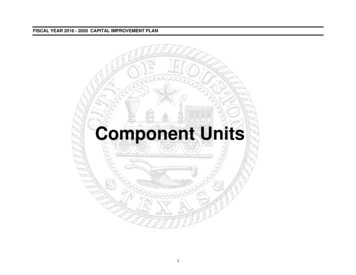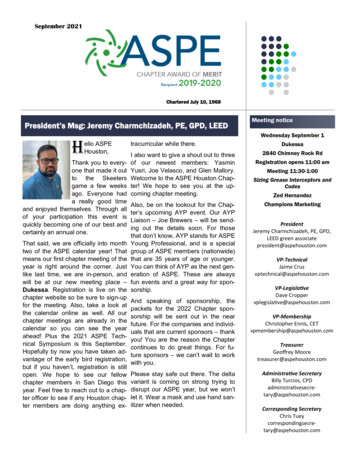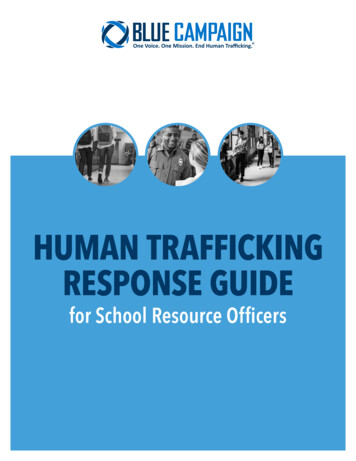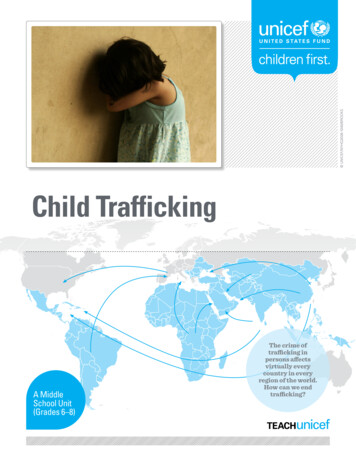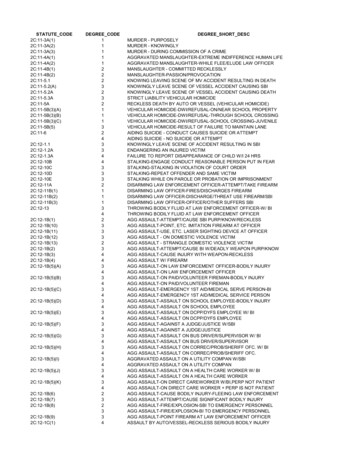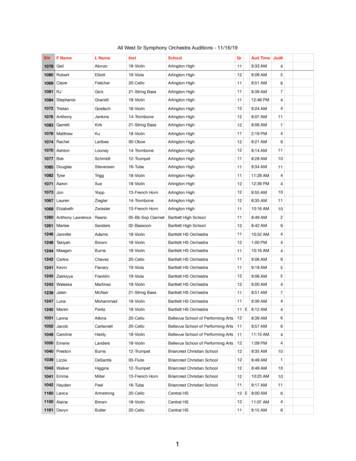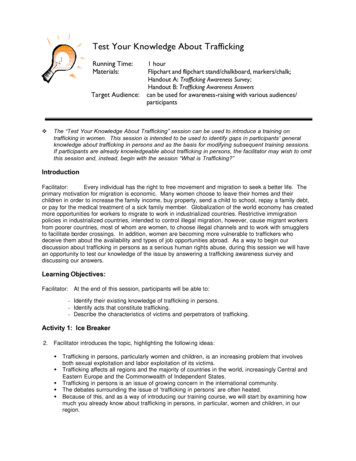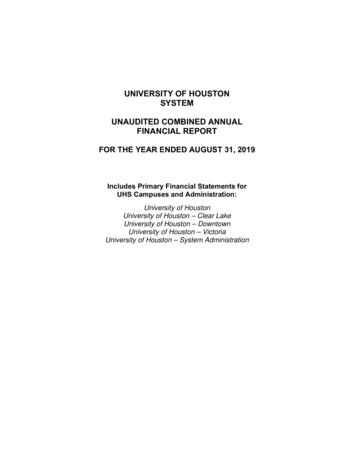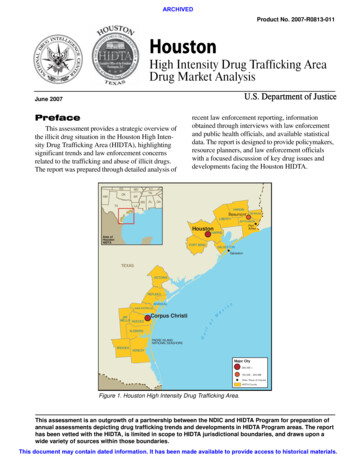
Transcription
ARCHIVEDProduct No. 2007-R0813-011HoustonHigh Intensity Drug Trafficking AreaDrug Market AnalysisU.S. Department of JusticeJune 2007PrefaceThis assessment provides a strategic overview ofthe illicit drug situation in the Houston High Intensity Drug Trafficking Area (HIDTA), highlightingsignificant trends and law enforcement concernsrelated to the trafficking and abuse of illicit drugs.The report was prepared through detailed analysis ofKSKilleenMOOKNMKYTNARMSTXrecent law enforcement reporting, informationobtained through interviews with law enforcementand public health officials, and available statisticaldata. The report is designed to provide policymakers,resource planners, and law enforcement officialswith a focused discussion of key drug issues anddevelopments facing the Houston RSONPortArthurHoustonHARRISArea ofHoustonHIDTAFORT AN PATRICIOCorpus Christixi cofMKLEBERGPADRE ISLANDNATIONAL SEASHOREBROOKSG ulfoJIMWELLS NUECESeKENEDYMajor City250,000 100,000 - 249,999Other Place of InterestHIDTA CountyFigure 1. Houston High Intensity Drug Trafficking Area.This assessment is an outgrowth of a partnership between the NDIC and HIDTA Program for preparation ofannual assessments depicting drug trafficking trends and developments in HIDTA Program areas. The reporthas been vetted with the HIDTA, is limited in scope to HIDTA jurisdictional boundaries, and draws upon awide variety of sources within those boundaries.This document may contain dated information. It has been made available to provide access to historical materials.
ARCHIVEDHouston High Intensity Drug Trafficking Area Drug Market AnalysisStrategic Drug ThreatDevelopments Houston is one of the most significant cocaineand marijuana distribution centers in the UnitedStates. Large quantities of cocaine and marijuana are distributed from Houston to numerousmarket areas, including Atlanta, Georgia; Chicago, Illinois; Miami, Florida; and NewOrleans, Louisiana.Houston has emerged as a principal transshipment center for Mexico-produced ice methamphetamine supplied by Mexican drug traffickingorganizations (DTOs) to major drug markets inthe southeastern and central United States.Transshipment through Houston will increase asdemand for high-purity ice methamphetaminecontinues to rise in these markets as well asthroughout the United States. Houston has become a significant source forpharmaceutical drugs distributed to markets outside the HIDTA region. The drugs, which primarily include hydrocodone and codeine, arediverted in Houston and distributed to marketsin the southeastern United States, includingGeorgia, Louisiana, and Mississippi. As a result of Hurricane Katrina, associationsbetween Houston and New Orleans drug traffickers are increasing. Many evacuees havereturned home to New Orleans and are using therelationships that they built with Houston-baseddrug traffickers to obtain significant quantitiesof illicit drugs for distribution in Louisiana. Methamphetamine production has considerablydecreased over the past 3 years in the HoustonHIDTA region. This decrease is attributed toseveral factors, including precursor chemicalcontrol legislation enacted in Texas, the influxof ice methamphetamine from Mexico, and successful law enforcement programs.Drug Trafficking Organizations,Criminal Groups, and GangsDrug trafficking organizations are complexorganizations with highly defined commandand-control structures that produce, transport,and/or distribute large quantities of one or moreillicit drugs.Criminal groups operating in the United Statesare numerous and range from small to moderatelysized, loosely knit groups that distribute one ormore drugs at the retail and midlevels.Gangs are defined by the National Alliance ofGang Investigators’ Associations as groups orassociations of three or more persons with acommon identifying sign, symbol, or name, themembers of which individually or collectivelyengage in criminal activity that creates anatmosphere of fear and intimidation.HIDTA OverviewThe Houston HIDTA region, which encompasses 16 counties along the Gulf of Mexico insoutheastern Texas, is a key distribution and transshipment area for illicit drugs supplied to drugmarkets in the Midwest, Northeast, and Southeastand a consolidation point for the smuggling of drugproceeds into Mexico. The proximity of the Houston HIDTA region to the U.S.–Mexico border andthe Gulf of Mexico makes the area susceptible todrug trafficking as well as other national securityand law enforcement threats such as alien smuggling, weapons trafficking, and terrorist entry intothe United States. Houston, located in HarrisCounty, is the principal drug market area in theHIDTA region; however, other smaller, outlyingdrug markets exist in the area, including CorpusChristi and Beaumont/Port Arthur.Mexican DTOs exploit the geography andeconomy of the Houston HIDTA region to smuggleillicit drugs from Mexico and to launder their illicitproceeds. The HIDTA region’s geographic makeupvaries from sparsely populated ranchland in thesouth to major metropolitan areas in the north—including Houston, the fourth-largest city in theUnited States. A large segment of the HIDTAregion is located along undeveloped areas of the2This document may contain dated information. It has been made available to provide access to historical materials.
ARCHIVEDNational Drug Intelligence CenterGulf Coast, which are susceptible to maritime drugsmuggling from Mexico. Well-developed economic and financial infrastructures in metropolitanareas of the HIDTA region, particularly in Houston, provide DTOs with the means to launder drugproceeds through traditional financial institutionsand money services businesses (MSBs).The Houston HIDTA region has a dynamictransportation infrastructure that offers DTOsextensive land, sea, and air modes of transportation. Overland transportation through an intricatenetwork of interstates, highways, advanced secondary routes, and railroads provides DTOs withnumerous means by which to smuggle illicit drugsinto and through the area. Moreover, Houston is amajor hub for the trucking industry; tractor-trailersare commonly used by DTOs to smuggle largedrug shipments from Mexico through the HIDTAregion to markets throughout the United States.The Houston HIDTA region’s transportation system also is supported by four major railroads inHouston, Beaumont/Port Arthur, and CorpusChristi, which provide access to Mexico. Drugsmuggling by sea and air conveyances poses amoderate threat to the Houston HIDTA region,which contains or immediately borders 10 seaports.The sheer volume of maritime traffic and foreigncargo that passes through these ports offers anotheravenue for drug smuggling. The Port of Houstonhas long been the nation’s leading port for foreigntonnage and is the sixth-largest seaport in theworld. The Padre Island National Seashore (PINS),an undeveloped natural barrier island that extendssouth from Corpus Christi to the Mansfield Channel, poses an additional maritime smuggling threatto the area. Commercial aircraft are also used bytraffickers to smuggle drugs and U.S. currencythrough the three major international airports in theHouston HIDTA region; however, increased security at these facilities since September 11, 2001,has decreased drug trafficking by aircraft.Drug Threat OverviewThe Houston HIDTA region is a primary distribution and transshipment area in the United States fordrugs smuggled from Mexico to U.S. drug markets.Table 1. Houston HIDTA Drug Seizuresby Drug, 2004–2006DrugPowder Cocaine (kg)Crack Cocaine (kg)Heroin (kg)Marijuana (kg)Methamphetamine (kg)MDMA 38,90186,8246751807458,00313,112316,925Source: Houston High Intensity Drug Trafficking Area.The large-scale transportation and distribution ofillicit drugs and laundering of drug proceeds are themost significant illicit drug issues facing the HoustonHIDTA region, requiring a large commitment of lawenforcement resources from member agencies in theHIDTA region as shown by the amount of drugsseized in the HIDTA region. (See Table 1.) Wholesalequantities of illicit drugs, particularly cocaine andmarijuana, are transported from Mexico throughSouth Texas to the HIDTA region, primarily to Houston and Corpus Christi, where they are distributed tomajor markets throughout the United States, including Atlanta, Georgia; Chicago, Illinois; Dallas, Texas;Denver, Colorado; Detroit, Michigan; Los Angeles,California; New York, New York; Philadelphia, Pennsylvania; and St. Louis, Missouri. Wholesale quantities of ice methamphetamine are transported to theregion and distributed to markets in the southeasternand central United States. Heroin and MDMA(3,4-methylenedioxymethamphetamine, also knownas ecstasy) are also distributed to markets outside theHIDTA region, but to a much lesser extent. Additionally, some wholesale quantities of drugs remain in theHIDTA region for local distribution.Illicit drug production in the Houston HIDTAregion generally entails crack conversion, limitedcannabis cultivation, and decreasing methamphetamine production. The number of seized methamphetamine laboratories decreased 81 percent from2004 to 2006 in the Houston HIDTA region, a development that can be largely attributed to an influx of3This document may contain dated information. It has been made available to provide access to historical materials.
ARCHIVEDHouston High Intensity Drug Trafficking Area Drug Market AnalysisTable 2. Methamphetamine Laboratories Seizedin the Houston HIDTA Region, by County2004–2006Seized Methamphetamine LaboratoriesHIDTACountyYear200420052006Fort Liberty400Nueces001San Patricio100Victoria11127115TotalSource: El Paso Intelligence Center National Clandestine LaboratorySeizure System, run date 05/04/07.ice methamphetamine from Mexico, recently enactedprecursor chemical control legislation, and successfullaw enforcement programs. (See Table 2.)The distribution and abuse of illicit drugs in theHouston HIDTA region place substantial societaland financial burdens on communities and local,state, and federal agencies. Crack cocaine is thedrug of choice for many drug abusers in urbanareas of the HIDTA region and has had a majorimpact on the level of violent and property crimeoccurring in many communities. Ice methamphetamine is increasingly being distributed and abusedin many areas of the HIDTA region, increasingmethamphetamine-related treatment admissionsand crime in these areas. Heroin abuse is a substantial problem in some HIDTA communities becauseof its highly addictive nature. MDMA, other dangerous drugs (ODDs), and pharmaceuticals, including codeine cough syrup and hydrocodone, aredistributed and abused in the HIDTA region aswell, particularly among the region’s youth.Drug TraffickingOrganizationsMexican DTOs pose the most significant organizational drug trafficking threat to the HoustonHIDTA region. Mexican DTOs have establishedbases of operation in the HIDTA region, particularlyin Houston and Corpus Christi, from which they distribute large quantities of drugs to major marketareas throughout the United States. Proximity to theU.S.–Mexico border and access to major drug market areas throughout the United States provide Mexican DTOs based in Mexico and in the HIDTAregion with an ideal location in which to operate.Mexican DTOs have established sophisticated trafficking networks that rely upon organization compartmentalization, alliances among DTOs,comprehensive security networks, and advancedcommunication techniques to conceal their drugtrafficking activities from law enforcement. Contributing to the magnitude of this threat is the ease withwhich Mexican DTOs adapt to law enforcementefforts to detect and dismantle their operations.Mexican DTOs—especially the Gulf Cartel andThe Alliance—operating in the Laredo and RioGrande Valley smuggling corridors, which lead intothe Houston HIDTA region—are engaged in a violent struggle for control of these areas. Violence hasescalated along the border, particularly in NuevoLaredo, where the Alliance is vying for control ofkey smuggling corridors that have been dominatedby the Gulf Cartel. The Gulf Cartel exerts considerable influence over Mexican transportation routesthrough Matamoros, Reynosa, Camargo, MiguelAlemán, and Nuevo Laredo. The Gulf Cartel also isthe most dominant DTO operating along the PINSand has nearly exclusive control of smuggling vessels heading north past Matamoros en route to theUnited States. The cartel uses Los Zetas, a paramilitary/criminal organization composed of deserters from the Mexican army’s elite Special AirMobile Forces, for enforcement. The Alliance, alsoknown as The Federation and The Golden Triangle,was formed in 2003 to counter the Gulf Cartel andis composed of leaders of several Mexican DTOsthat use Los Negros (also known as Los Lobos), aparamilitary/criminal group, for enforcement.4This document may contain dated information. It has been made available to provide access to historical materials.
ARCHIVEDNational Drug Intelligence CenterOther organizations operating in the HoustonHIDTA region include African American, Caucasian, Colombian, Dominican, Jamaican, and AsianDTOs and criminal groups. The presence of Colombian DTOs has decreased in the region in recentyears; they increasingly sell illicit drugs, particularlycocaine, directly to Mexican DTOs, who smuggleand distribute the drugs. Asian DTOs and criminalgroups, particularly Chinese and Vietnamese groups,are the principal MDMA traffickers in the HIDTAregion; they transport MDMA from Canada,primarily through Los Angeles, to Houston fordistribution. Additionally, Asian DTOs have beenlinked to indoor cannabis cultivation in the region.Prison gangs, street gangs, and outlaw motorcycle gangs (OMGs) distribute illicit drugs at thewholesale and retail levels in the Houston HIDTAregion. The majority of gangs in the region usedrug trafficking as their main source of income.Although most gangs distribute drugs at the retaillevel, some have developed relationships withMexican DTOs that allow them to obtain wholesalequantities of drugs directly from Mexico. Thesegangs are most prevalent in metropolitan areas,including Houston, Corpus Christi, and Beaumont,where violence associated with their drug- andgang-related activities is a considerable threat topublic and law enforcement safety. (See Table 3.)Table 3. Primary Gangs in the Houston HIDTA Region Involved in Violent Criminal Acts,Drug Trafficking, and Recruitment Activities*ActivityCity/CountyViolenceTexas SyndicateBaytownBeaumont/Port ArthurBrazoria County**Aryan Brotherhood of TexasCorpus ChristiFort Bend CountyHoustonMontgomery County**Texas SyndicateMexican MafiaAryan Brotherhood of TexasRecruitmentAryan Brotherhood of TexasHoustone Tango BlastPort Arthur Asian GangsPort Arthur Asian GangsAryan Brotherhood of TexasAryan Brotherhood of TexasAryan Brotherhood of TexasCripsAfrican American GangsAfrican American GangsPuro Michoacán KingsVatos Locos CripsVatos Locos Crips5-2 Hoover CripsEast Side Locos5-2 Hoover CripsCrips5-2 Hoover CripsBryan/College StationDrug Trafficking59 Bounty Hunter BloodsAsian BoyzEast Side LocosLatin KingsCripsCripsSur 1359 Piru BloodsSur 13Texas SyndicateAce of SpadesAce of SpadesMexican MafiaMexican Mafia59 Bounty HuntersUnknown59 Bounty HuntersNew Orleans Gangs59 Bounty Hunter BloodsHoustone Tango Blast59 Bounty Hunter BloodsHermanos Pistoleros LatinosSouthwest Cholos52 Hoover CripsMexican Mafia59 Bounty Hunter BloodsLatin KingsLatin KingsLatin KingsVarrio NorthsideAryan Brotherhood of TexasNew Orleans GangsBandidosTexas SyndicateRaza UnidaBandidosSource: Houston High Intensity Drug Trafficking Area Gang Threat Assessment 2006.* The table only includes the primary gangs operating in the described area and is not an all-encompassing list of gangs operating in the Houston HIDTA.** These counties are not part of the Houston HIDTA; however, their proximity to the HIDTA region impacts gang activity in the region.5This document may contain dated information. It has been made available to provide access to historical materials.
ARCHIVEDHouston High Intensity Drug Trafficking Area Drug Market AnalysisDrug MarketsThe Houston metropolitan area is the majordrug market in the HIDTA region; however, thereare several significant outlying markets, includingBeaumont/Port Arthur and Corpus Christi.Houston Drug MarketHouston is a major drug distribution center thatsupplies a vast number of market areas in theUnited States, including Atlanta, Chicago, Detroit,New York, and Philadelphia, with illicit drugs, primarily cocaine and marijuana. Houston’s welldeveloped highway system, established financialinfrastructure, racial and ethnic diversity, and largevolume of international trade contribute to theregion’s role as a major transshipment point forillicit drugs destined for U.S. drug markets and fordrug proceeds destined for Mexico. The significantnumber of drug-related investigations throughoutthe United States that are linked to the city, including those in Atlanta, Chicago, Miami, Newark,New Orleans, New York, and St. Louis, furtherdemonstrates Houston’s role as a key national drugdistribution and money laundering center.ProductionDrug production in Houston is limited becauseof the ready availability of drugs from Mexico;however, powder cocaine is converted to crack,cannabis is cultivated, and methamphetamine isproduced to varying degrees. Significant amountsof powder cocaine are converted into crack cocainewithin the city for local and regional consumption.Crack cocaine is often converted in places such ascrack houses, hotel rooms, and garages.The ready availability of Mexican marijuanarenders most domestic cultivation of cannabisunnecessary; however, outdoor and indoor growoperations have been seized by law enforcementofficials in and around Houston. The mild climatein the Houston area as well as the rural areas surrounding the city makes the area conducive to outdoor cannabis cultivation; however, outdoor growsites are rarely found. Indoor grow sites are notgenerally considered a major drug enforcementproblem; however, in March 2006, a sophisticatedindoor cannabis grow operated by two individualsof Vietnamese descent was found in a residentialhome in Montrose, a neighborhood near downtownHouston, that contained approximately 1,000 cannabis plants worth an estimated 4 million as wellas hydroponic equipment, a watering system, fertilizer, and insecticide. Every room in the home wasused for cultivation, indicating that the primarypurpose of the residence was cannabis cultivation.Cultivation of high-potency marijuana can be verylucrative to producers because the drug is increasingly popular throughout the United States and canbe sold at higher profits in most drug markets.Methamphetamine production has considerablydecreased over the past 3 years in Harris County.According to the El Paso Intelligence Center(EPIC) National Clandestine Laboratory SeizureSystem (NCLSS), the number of methamphetamine laboratories seized by law enforcement inHarris County decreased by 89 percent from 2004to 2006. (See Table 2 on page 4.) Since the enactment of precursor chemical control legislation inAugust 2005, methamphetamine production hasdecreased significantly; however, methamphetamine producers still attempt to circumvent thisnew law by using fraudulent identification toobtain pseudoephedrine through retailers, turningto new sources of supply for the precursor, or usingalternative production methods.1 Additionally, thewide availability of Mexican ice methamphetaminein the HIDTA region makes production an unnecessary risk when the drug can easily be obtainedfrom distributors in the area.1. In August 2005, Texas passed precursor control legislation that required pharmacies that engage in over-the-counter (OTC) sales of tabletforms of products containing ephedrine, pseudoephedrine, or norpseudoephedrine to keep those products behind the pharmacy counter or in alocked case within 30 feet and in a direct line of sight from a pharmacy counter staffed by an employee of the pharmacy. The state law does notapply to liquid, liquid capsule, or liquid gel capsule forms of the products. Additionally, before completing the OTC sale of a product containingthe above-mentioned precursors, a pharmacy must ask for photo identification and signature from the buyer and record the name of the personmaking the purchase, the date of purchase, and the item and number of grams purchased. Individuals may not purchase more than two packagesor 6 grams of ephedrine, pseudoephedrine, norpseudoephedrine, or a combination of those substances at a time.6This document may contain dated information. It has been made available to provide access to historical materials.
ARCHIVEDNational Drug Intelligence Center§ 5945 OrangeBeaumont281Austin 77HOUSTONINTLHouston§ § 35SANANTONIOINTLo" n10Texas City 5935 281 n77TEXASPortArthur10Houstonn nSabinePasadena10§ "o San Antonio§ § Beaumontn n nn GalvestonFreeportVictoria n§ 37 281 CORPUSCHRISTIINTL59o n "Corpus ChristieCorpus Christif D")Sarita281 Hidalgo250,000 100,000 - 249,999o" nD McAllen)"D)"HIDTA CountyMajor City75,000 - 99,99977Rio Grande CityoG ulfD")icMoFalfurriasxD") 281ProgresoME X IC OD)"D")BrownsvilleD)"International AirportMajor SeaportPort of EntryCheckpointInterstateBrownsvilleU.S. HighwayFigure 2. Houston HIDTA transportation infrastructure.TransportationHouston is a primary transshipment point used byMexican DTOs to smuggle enormous amounts ofdrugs from Mexico, primarily cocaine and marijuana,through the Rio Grande Valley and from other areasof the Texas–Mexico border. Mexican DTOs use various transportation methods to smuggle drugs toHouston; however, overland transportation, primarilyusing private and commercial vehicles on interstatesand highways, is predominant. (See Figure 2.) DTOstypically use U.S. Highway 59 to transport illicitdrugs from the Southwest Border to Houston. US 59extends directly from the Laredo port of entry (POE)to Houston and also connects with US 281 and US77, which provide routes of travel from the McAllenand Brownsville areas. Drug shipments also aretransported into Houston on Interstate 10, whichprovides access into the city from El Paso throughSan Antonio. Additionally, the proposed TransTexas Corridor, or I-69, which will eventuallyexpand from Mexico to Canada traversing the Houston area, will quite likely be used by Mexican DTOs,upon its completion, to smuggle drug shipments.Mexican DTOs also use couriers on buses andtrains to transport illicit drugs to Houston. There areat least two Mexican-owned bus companies thatoperate daily routes from Mexico through Houston7This document may contain dated information. It has been made available to provide access to historical materials.
ARCHIVEDHouston High Intensity Drug Trafficking Area Drug Market Analysisto destinations in Florida, Georgia, North Carolina,South Carolina, and Virginia. Couriers on thesebuses transport cocaine, marijuana, and methamphetamine for distribution in these states; they alsotransport drug proceeds back to Mexico. Additionally, several rail systems exist in the Houston area,including the Texas Mexican Railway, which is verylikely used by Mexican DTOs to transport drugsfrom Mexico to Houston as well as from Houston tomarket destinations outside the HIDTA region.2container handling capacity when fully developed,allowing it to handle 2.3 million TEUs (twentyfoot-equivalent lengths). By 2008 the Port of Houston will also open a cruise ship terminal with thecapacity to accommodate as many as 1.7 millionpassengers. The increase in the number of containers processed through the port facilities and theaddition of a large cruise ship terminal couldenable DTOs to more easily smuggle illicit drugshipments using maritime methods.Various DTOs exploit air conveyances in Houston to transport illicit drugs to the HIDTA region;however, drug transportation through airports inHouston has decreased as a result of increasedsecurity at commercial air facilities since September 11, 2001. Law enforcement agencies occasionally seize drugs and currency from passengers ondomestic and international flights and from freightarriving at the George Bush Intercontinental Airport and Hobby Airport. The large number of passenger and cargo activities at these airportsprovides camouflage to traffickers who smuggleillicit drugs through these airports. Over 51 millionpassengers and 367,000 metric tons of air cargopassed through these airports in 2006. Additionally,the first scheduled Asian cargo flight to Houstonoccurred in September 2006; this flight, which willfly round trip from Taipei, China, to Houston oncea week, could potentially be used by traffickers tosmuggle illicit drugs from Asia.DistributionMaritime smuggling through the Port of Houston poses a viable threat to the HIDTA region thatcould increase in the long term. The Port of Houston facilities, through which more than 200 milliontons of cargo moved in 2006, is ranked first in theUnited States in foreign waterborne tonnage, second in the United States in total tonnage, and tenthin the world in total tonnage. The Port of Houstonopened the Bayport Container Terminal in February2006, which is expected to triple the port’sHouston is a distribution center used by numerous traffickers to supply illicit drugs to major market areas throughout the United States as well as tosupply dealers within the HIDTA region. Cocaine,marijuana and, to a lesser extent, heroin, methamphetamine, and MDMA are transshipped fromHouston to major market areas such as Atlanta,Chicago, Dallas, Denver, Detroit, Kansas City, LosAngeles, New York, Philadelphia, and St. Louis.Once drug shipments arrive in Houston, they areoften stored at local stash sites pending further distribution to drug markets. Drug trafficking operations are extremely vulnerable at these stash sites;seizures of illicit drugs from locations where largequantities are stored typically result in a muchgreater loss for DTOs.Houston is one of the most significant cocainedistribution centers in the United States. Accordingto Texas Department of Public Safety (DPS) seizure data, the amount of cocaine seized in HarrisCounty increased from approximately 14 kilograms in 2005 to 291 kilograms in 2006.3 (SeeTable 4 on page 9.) Furthermore, the number ofseizure incidents increased from 11 in 2005 to 40 in2006. Cocaine seizure data show that large quantities of cocaine are distributed from Houston tonumerous cocaine market areas, including Atlanta,Chicago, Columbus, Ohio; Jackson, Mississippi;and New Orleans.2. The Texas Mexican Railway is a 157-mile rail line between Laredo and Corpus Christi, Texas. This railway also provides service to Houstonand Beaumont, Texas, through trackage rights—an arrangement between railroad companies that permits one company to operate over certainsections of track owned by another railroad company.3. These data are limited to Texas Department of Public Safety (DPS) seizure data and are not inclusive of all seizures in the HIDTA. Only 2years of data are available for comparison purposes.8This document may contain dated information. It has been made available to provide access to historical materials.
ARCHIVEDNational Drug Intelligence CenterTable 4. Texas Department of Public Safety Drug Seizures, by Drug, in Harris County, estination StatesLouisiana, Mississippi, andTexasCocaine14 kg11Heroin5 kg3MarijuanaMethamphetamineMDMA2006TexasAlabama, Florida, Georgia,Kentucky, Louisiana, Mississippi, North Carolina,South Carolina, Tennessee,and Texas887 kg381 kg2Texas3Texas0.1 kg77 duSeizureAmountNumberofSeizures291 kg402 kg3Destination StatesAlabama, Florida, Georgia,Illinois, Louisiana, Mississippi, Ohio, Texas, and VirginiaLouisiana and TexasAlabama, Florida, Louisiana,Mississippi, North Carolina,Ohio, South Carolina, andTexas1,906 kg751 kg6Texas and Louisiana6Texas and Louisiana0.1 kg492 duSource: Texas Department of Public Safety.*These data are limited to Texas Department of Public Safety seizure data and are not inclusive of all seizures in the HIDTA region. Only 2 years of data areavailable for comparison purposes. (Collection date 04/10/07)Houston is one of the principal transshipmentareas in the United States for marijuana, and theamount seized has increased over the past year.According to Texas DPS seizure data, the amount ofmarijuana seized in Harris County more than doubled from 2005 (887 kg) to 2006 (1,906 kg). (SeeTable 4.) These marijuana shipments were destinedfor markets such as Charleston, South Carolina;Jackson, Mississippi; Huntsville, Alabama; Miami,Orlando, and Tampa, Florida; and New Orleans.Furthermore, over the past year several large seizures of marijuana have occurred in the area, confirming Houston’s role as a principal transshipmentarea. In March 2007 law enforcement seized over9,000 kilograms of marijuana from two schoolbuses and two rental vans on a property located insoutheast Houston. In December 2006 the HarrisCounty Sheriff’s Office seized 502 bales of marijuana that weighed nearly 7,000 kilograms and hada street value of approximately 25 to 40 million.Additionally, in November 2006 the Houston PoliceDepartment seized approximately 10,000 kilogramsof marijuana during a similar incident.Houston has emerged as a significant transshipment area for ice methamphetamine transportedfrom Mexico and distributed to market areas in theeastern and central United States. Houston islocated in a prime area for methamphetaminetransshipment; it is close to Mexican sources ofsupply and to major methamphetamine marketareas in the southeastern and central United States.Houston has also become a significant sour
Drug Market Analysis Houston Product No. 2007-R0813-011 June 2007 Preface This assessment provides a strategic overview of the illicit drug situation in the Houston High Inten-sity Drug Trafficking Area (HIDTA), highlighting significant trends and law enforcement concerns related to the trafficking and abuse of illicit drugs.
